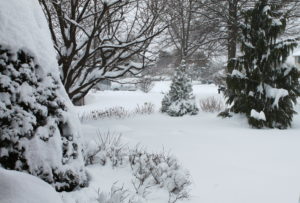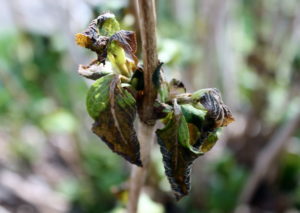Snow First Would’ve Been Nice
March 19th, 2017
Well, there went the ridiculously early spring in a hurry.
Just when you (and our landscape plants) thought spring was happening way ahead of time this year, along came a string of sub-20-degree nights and a very big dumping of snow to remind us that the calendar still says winter.
I’m not so much concerned about the damage from my 15 inches of snow as I am the 17-degree nights we had last weekend — before Storm Stella’s arrival.
Yeah, lots of snow can snap tree limbs and splay apart evergreens, but it also is good at insulating the crowns and buds of low plants. A white blanket of snow keeps temperatures around 32 degrees, which is far better than having 17-degree winds nipping at our bare buds and crowns.
If we were going to get a foot or more of snow, it would have been better to get it before the bud-killing cold. But since we can’t order the weather or do anything about it, all that’s left is to wait for the snow to melt and pick up the pieces later.
Before the snow came, I noticed that most of the prematurely opened leaves on my roses, hydrangeas and elderberries had browned. Those leaves most likely are toast already, but the good news is that most woody plants have dormant buds that should push out new leaves when the “real” spring occurs.
The bad news, though, is that plants that pushed flower buds along too far after the sustained warmth of February and early March probably won’t flower this year. I’m particularly concerned about hydrangea buds, which got zapped last year when temperatures nosedived into the low 20s the third week of April and which suffered in the polar vortexes of the two Januaries before that.
This could be another hydrangea-less June, although the plants themselves should be fine. Hydrangea leaves are nice, but they’re not why so many gardeners plant this usually showy shrub.
This crazy weather year is another argument for switching away from big-leafed hydrangeas (Hydrangea macrophylla) and toward oakleaf, smooth and panicle hydrangeas (H. quericifolia, H. arborescens, H. paniculata) since these types are either cold-hardier or bloom on new wood that has yet to grow. Mountain hydrangeas (H. serrata) are another option that look like big-leaf hydrangeas but have cold-hardier buds, albeit less showy in the bloom department.
Fruit trees, such as early-to-flower apricots, plums and peaches, also may have suffered flower-bud damage, which then translates into less or no fruit.
Prematurely developed perennials are another concern. The key is how much damage the crowns (growing points) sustained.
Perennial growers will tell you their biggest loss in overwintering perennials is not heading into winter or during winter, but coming out of winter. The threat is that temperatures will warm too much inside greenhouses, causing growth to start and progress sooner and faster than it ought to.
If sudden cold comes along, the crowns can die at temperatures they otherwise would’ve withstood when dormant.
I saw leaf browning on some of my emerged perennials before the snow, but I think the crowns were still intact. When the snow melts, look to the base of your perennials. If there’s no growth yet or green showing, that’s good. If the crown is discolored or showing signs of brown or black mush, that’s a problem.
When too much damage happens to the crown of a perennial, it’s a goner. Browned leaves can be snipped off to make way for new leaves growing from the crowns later, but without a live crown, there’s nothing left to produce leaves.
Usually, we can count on spring bulbs to weather just about anything that erratic spring weather can throw at them. But this year, my just-blooming daffodils keeled over after those sub-20-degree nights.
That’s not a good sign. The stems look to have frozen. I’ve never seen that in my 35 years of gardening.
The bulbs themselves should be fine, but I suspect the flower stalks are going to be a droopy mush when the snow is gone.
Maybe things aren’t as bad as they seem at this point. Plants are often more resilient than we give them credit for. Here’s hoping they pleasantly surprise.









